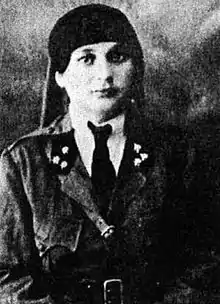Nazik al-Abid نازك العابد | |
|---|---|
 Al-Abid in military garb before the Battle of Maysalun, 1920 | |
| Born | Nazik Khatim Al ʿAbid Bayhum 1887 Damascus, Ottoman Syria |
| Died | 1959 (aged 71–72) Damascus, Syria |
| Nationality | Syrian |
| Other names | Joan of Arc of the Arabs |
| Education | BA in agriculture from Women's College in Istanbul |
| Occupation(s) | women's rights activist, nationalist, and critic of Ottoman and French colonialism in Syria |
Nazik Al Abid (Arabic: نازك العابد; 1887–1959) known as the "Joan of Arc of the Arabs"[1] was a Syrian women's rights activist, nationalist, and critic of Ottoman and French colonialism in Syria.[2] She was the first woman to earn rank in the Syrian Army for her role in forming the Red Star Society, a precursor to the International Red Cross and Red Crescent Movement, during the battle of Maysalun. She was a revolutionary for national independence and women's right to work and vote in Syria.[3]: 61
Activism
Against Ottoman Empire
Abid was an activist for women's suffrage and resistance to the Ottoman occupation of Syria, often writing under a male pseudonym[4] for Damascus newspapers during the 1919 Syrian women's movement.[5]: 120 She established a group to advocate for women's rights in 1914, and was exiled to Cairo by Ottoman leadership, where she stayed until the collapse of the Ottoman Empire in 1918.[6] In 1919, Abid founded Nur al-Fayha' (Light of Damascus) society and magazine, and later, in 1922, a school of the same name which offered English and sewing courses for young girl orphans of the war dead.[5][3]: 61
Against French occupation of Syria
As the head of a women's delegation to the King-Crane Commission, Abid spoke to American diplomats without a veil to signal her intention for a secular rule of Syria, and to testify against the French mandate for occupation.[6]
In 1920, Abid founded the Red Star Association, an early form of the Red Crescent Society, and was awarded the rank of "honorary president" of the Syrian Army by Prince Faysal.[7] Abid led Red Star nurses in the Syrian Army's battle against French forces during the Battle of Maysalun in July 1920. Despite being exiled by the French government after the defeat of the Syrian Army, Abid was hailed domestically as the Joan of Arc of Syria.[7] As the first woman general in Syria, she was photographed in military uniform and without a hijab, but returned to wearing a veil after outcry from conservatives.[5]: 128
The French government granted her amnesty in 1921, and Abid returned to Syria on the condition that she avoid politics.[7] After founding the Light of Damascus school that year - viewed as competition for resources with French humanitarian agencies and programs[8]: 95 —the French authorities threatened to arrest her, and she fled Syria for Lebanon.[9]
Women's rights
In 1933 she founded Niqâbat al-Mar'a al-'Amila (The Working Women's Society), which worked on labor issues on behalf of women in Syria, advocating economic liberation as a means to political liberation for women.[3]: 73
Personal life

Abid was born into an influential Damascene family.[7] Her father, Mustafa al-Abid, was an aristocrat charged with administrative affairs in Kirk and later as an envoy to Mosul under Ottoman Sultan Abdulhamid II; she was the niece of Ahmad Izza al-Abid, a judge and advisor to the sultan.[9] While living in Turkey, she was educated in several languages in Turkish, American and French schools. She graduated with a BA in agriculture from the Women's College in Istanbul.[10] Her family was exiled to Egypt for ten years after the CUP 1908 revolution.[9]
In 1922, after her exile to Lebanon, she met and married Lebanese intellectual and politician, Muhammad Jamil Bayhum.[3]: 59
Further reading
- Moubayed, Sami M. (2006). Steel & Silk: Men and Women who Shaped Syria 1900-2000. Cune Press. p. 360-. ISBN 9781885942418.
References
- ↑ Zachs, Fruma; Ben-Bassat, Yuval (2015). "Women's Visibility in Petitions from Greater Syria During the Late Ottoman Period". International Journal of Middle East Studies. 47 (4): 765–781. doi:10.1017/S0020743815000975. ISSN 0020-7438. S2CID 164613190.
- ↑ Al-Hassan Golley, Nawar; Homsi Vinson, Pauline (2012). "3". In Arenfeldt, Pernille; Al-Hassan Golley, Nawar (eds.). Mapping Arab Women's Movements : A Century of Transformations from Within. Cairo, Egypt: The American University in Cairo Press. p. 67. ISBN 9789774164989.
- 1 2 3 4 Zachs, Fruma (2013). "Muḥammad Jamīl Bayhum and the Woman Question". Die Welt des Islams. 53 (1): 50–75. doi:10.1163/15700607-0003A0003.
- ↑ Talhami, Ghada (2013). Historical dictionary of women in the Middle East and North Africa. Lanham, Md.: Scarecrow Press. p. 11. ISBN 978-1885942401.
- 1 2 3 Thompson, Elizabeth (May 2011). "The woman's movement and its development. The colonial Welfare state in Syria (1920-1946)". Clio. Femmes, genre, histoire (33): 107–124. doi:10.4000/clio.10030.
- 1 2 Moubayed, Sami (2006). Steel & Silk: Men and Women who Shaped Syria 1900-2000. Cune Press. p. 360. ISBN 9781885942401.
- 1 2 3 4 Zachs, Fruma; Halevi, Sharon (2014). Gendering Culture in Greater Syria: Intellectuals and Ideology in the Late Ottoman Period. I.B.Tauris. p. 124. ISBN 978-0857736727.
- ↑ Thompson, Elizabeth (2000). Colonial Citizens: Republican Rights, Paternal Privilege, and Gender in French Syria and Lebanon. New York: Columbia University Press. pp. 121. ISBN 9780231106603.
- 1 2 3 Meininghaus, Esther (2016). Creating Consent in Ba'thist Syria: Women and Welfare in a Totalitarian State. I.B.Tauris. ISBN 9780857729774.
- ↑ Moubayed, Sami M. (2006). Steel & silk : men and women who shaped Syria 1900-2000. Seattle, WA: Cune. p. 360. ISBN 9781885942401.
External links
 Media related to Naziq al-Abid at Wikimedia Commons
Media related to Naziq al-Abid at Wikimedia Commons